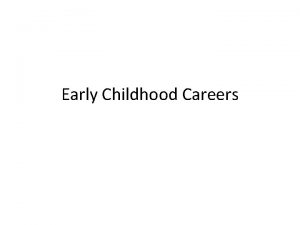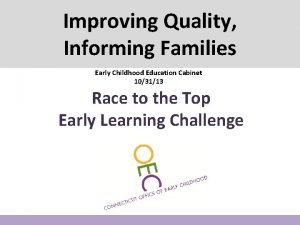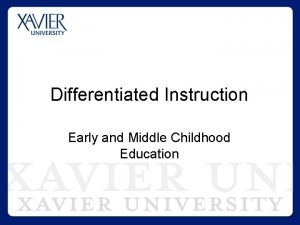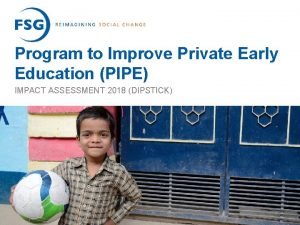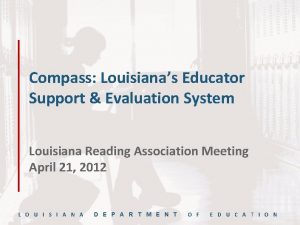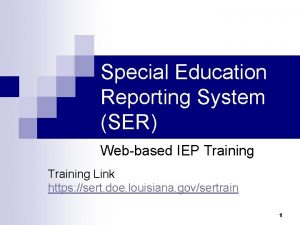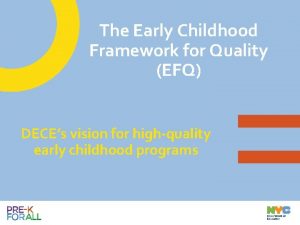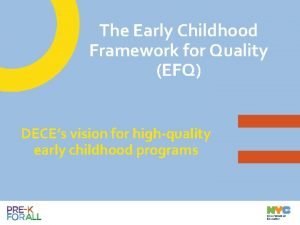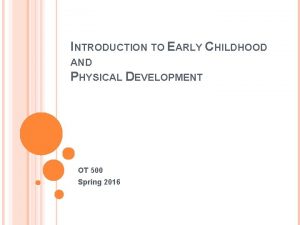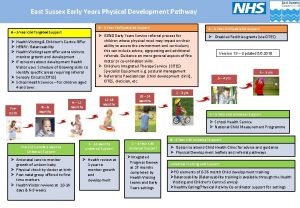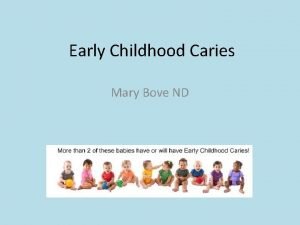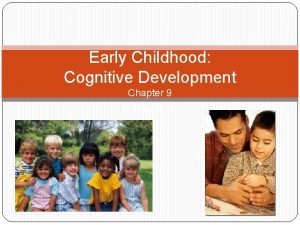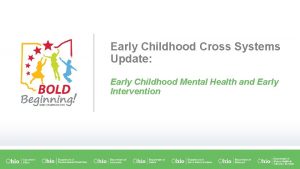LDOE Early Childhood Education Northwest Louisiana Early Childhood




































- Slides: 36

LDOE - Early Childhood Education Northwest Louisiana

Early Childhood Statistics Brain Development The first five years are the most critical in the development of a child’s brain. From birth to age three, children grow and learn at the most intense rate, forming more than a million neural connections every second; these are the years when children are learning how to learn. 90% of a child’s brain development happens before age 5. [1] 2

Early Childhood Statistics Achievement Gaps Achievement gaps develop well before children begin kindergarten. Unfortunately, many children who do not participate in high-quality early childhood programs are not fully prepared to begin school. Those most likely to begin kindergarten at an academic disadvantage are low-income and minority children. Children from disadvantaged families have less than 50% of the vocabulary their more affluent peers do. [2][3] 3

Early Childhood Statistics Smart Investment Higher returns than preschool alone. Every dollar invested in high-quality birth-to-five early childhood education for disadvantaged children delivers 13% annual return on investment, significantly higher than the 7 -10% return delivered by preschool alone. [4] 4

Overview of Louisiana’s System 5

Overview of Louisiana’s System Louisiana’s Vision for Early Childhood Louisiana has been striving to achieve the goals of Act 3 (2012), including the creation of a statewide early childhood network with a unified rating system and coordination of services and engagement across b-5 programs. 6

Overview of Louisiana’s System Building on the Work of Act 3 7

Overview of Louisiana’s System Building on Act 3 (2012) Vision While the state has worked to implement the vision of Act 3, Louisiana’s youngest children still struggle to access the high-quality care and services they need to be ready for school and beyond. Key Area Vision Local Governance Communities drive faster rates of quality improvement and expanded access. Quality Children participate in active learning in birth to five classrooms, led by teachers and leaders that are fully able to prepare them for kindergarten and beyond. Access More young children access high-quality care through a mixed delivery system. 8

Overview of Louisiana’s System Louisiana’s Focus on ECE With the successes of Act 3 implementation, there is an increased focus statewide on increasing awareness of and investment in local and state birth to five pathways. • • Louisiana’s legislature convened a blue ribbon Early Childhood Care and Education Commission to study and make recommendations about the next phase for the state’s early childhood system: • Executive Summary (LA B to 3) • Legislative Report (LA B to 3) Louisiana secured nearly $8 MM to support and improve the birth to five pathway: • Preschool Development Grant Birth through Five (PDG B-5) Louisiana launched nationally innovative Ready Start Network pilots Louisiana’s early childhood efforts received national, state, and local attention: • Early Care and Education System State-by-State Analysis, Bipartisan Policy Center • Lessons from the Bayou State, Three Reforms for Improving Teaching and Caregiving, New America 9

Overview of Louisiana’s System Current Landscape Statewide/Northwest Louisiana In Northern Louisiana, nearly all of the economically disadvantaged 4 -year-olds are enrolled in publiclyfunded programs, but there is an opportunity to improve the typical quality of care provided. Statewide (Preliminary) Northwest Louisiana (Preliminary) ● Over 15, 000 observations of 5, 500 classrooms in 1, 605 sites ● Over 2, 000 observations of 724 classrooms in 193 sites ● The statewide average score on CLASS® is 5. 14 ● 85% of sites are rated Proficient or higher ● 38% of sites fall into the range for the new High Proficient rating ● The regional average score on CLASS® is 5. 12 ● 90% of sites are rated Proficient or higher ● 40% of sites fall into the range for the new High Proficient rating ● There are ~ 1, 300 certified local CLASS® observers ● 22% of domains checked by third party observers were replaced ● There are 193 certified local CLASS® observers ● 21% of domains checked by third party observers were replaced ● The state is serving 94% of economically disadvantaged 4 year-olds, but 14% of birth to 3 -year-olds ● The region is serving 95% of economically disadvantaged 4 year-olds, but 15% of birth to 3 -year-olds 10

Louisiana’s Quality Rating System 11

Louisiana’s Quality Rating System What is the CLASS® tool? The Classroom Assessment Scoring System (CLASS)® tool measures the quality of teacher-child interactions, is correlated to educational outcomes for children, and is used in classrooms serving children from birth to pre-K in Louisiana. Expectations for the Classroom: Pre. K Domains Warm, positive environment with trusting relationships Emotional Support Daily routines are organized and disruptions are minimal Classroom Organization Children are supported to learn concepts, develop language, and connect ideas through dialogue and play Instructional Support Toddler Domains Emotional & Behavioral Support Infant Domains Responsive Caregiving Engaged Support for Learning 12

Louisiana’s Quality Rating System Overview of CLASS® in Louisiana Each site receives a performance score and performance rating based on CLASS® observations, and this information is published on the site’s performance profiles found at www. Louisiana. Schools. com. Overall CLASS Score Range Performance Rating Sites in 20172018 6. 00 - 7. 00 Excellent 5. 25 - 5. 99 High Proficient (*NEW* in 2019) 527 (33. 1%) 4. 50 - 5. 24 Proficient 608 (38. 2%) 3. 00 - 4. 49 Approaching Proficient 360 (22. 6%) 1. 00 - 2. 99 Unsatisfactory 90 (5. 7%) 5 (0. 3%) For more detailed information about how performance scores and ratings are calculated, refer to the Performance Profile FAQs There are incentives and consequences tied to performance: ● Tax credits and bonuses for child care centers have been revised to reward and incentivize performance and improvement ● Programs that score below 3. 75 will be required to participate in a Site Improvement Planning process ● Programs that score Unsatisfactory for two years in any three year period may lose Type III license or funding 13

Louisiana’s Quality Rating System Site Improvement Since 2016 -2017 PRELIMINARY DATA Based on preliminary results, 127 more sites (7%) achieved Proficient or above in 2018 -2019, indicating more children across the state are receiving quality care and education than in years past. 14

Louisiana’s Quality Rating System Improvement by Domain PRELIMINARY DATA The statewide average overall score and the average on each domain has improved incrementally and steadily each year. 15

Louisiana’s Quality Rating System Improvement by Program Type PRELIMINARY DATA The statewide average score for each program type has improved incrementally each year, resulting in more sites providing quality care and education for children. 16

Louisiana’s Quality Rating System Impact of High Proficient PRELIMINARY DATA Based on preliminary results, 40% of sites will be rated Proficient and 38% of sites will be rated High Proficient. 17

Louisiana’s Quality Rating System Distribution in Change of Scores PRELIMINARY DATA 65% of sites with two years of data improved their overall score in 2017 -2018, while only 34% of sites showed decline in score. 18

Louisiana’s Quality Rating System Site Improvement Planning PRELIMINARY DATA Low-performing centers require support to plan and access resources available to them in their community to meet their goals to improve classroom quality. • In August 2018, low-performing sites scoring below 3. 75, based on 2017 -2018 preliminary performance scores, were notified regarding their mandated participation in Early Childhood Site Improvement Planning. • Directors worked closely with a regional Department field support consultant to create an improvement plan based on individualized site needs and self-assessment results. • The Department has been closely monitoring the progress of these sites and offering prioritized resources and support (e. g. , Resource & Referral, curriculum support, mental health consultation). Early results show the success of this intervention: 95% of participating sites have improved this year, compared to only 33% of Approaching Proficient sites that did not participate; 45% of participating sites are showing growth of 1 point or higher, compared to fewer than 1% of other Approaching Proficient sites. 19

Louisiana’s Quality Rating System Site Improvement Planning PRELIMINARY DATA 95% of low-performing sites participating in the Site Improvement Planning process showed improvement based on 2018 -2019 preliminary scores. 46% displayed growth of 1 point or higher. The 4 sites participating in Northwest Louisiana grew an average of 0. 98 points. 20

Louisiana Quality Rating System 2019 -2020 Site Improvement Planning Key Features Due to the success of last year’s Site Improvement Planning, in 2019 -2020, additional sites are being recommended to participate. Three of these sites are in Northwest Louisiana. Key Features of the 2019 -2020 Expanded Site Improvement Planning Process: 1. Required Participation: All sites with 2018 -2019 preliminary scores below 3. 75 are required to participate in the Site Improvement Planning process as a result of policy. 2. 2018 -2019 SIP Sites: Field Support Consultants assessed individual site participation and score growth to determine the need for a second year of full or modified site improvement. 3. Additional Groups: Additional groups were targeted for support and recommended to participate. This includes sites with unsatisfactory 3 rd Party or local scores and sites with age range specific scores below 3. 75. 4. Monitoring for Improvement: The Department expanded strategies formal communication and tracking of interventions to better understand what is effective in supporting improvement. 21

Access to Quality 22

Access to Quality Challenges and Approach Challenge: While 94% of at-risk four-year-olds are served, fewer than 15% of in-need birth to three-yearolds can access an affordable quality seat. Approach: Louisiana finds creative solutions to increase access for its economically disadvantaged children ages birth through three. What success looks like: • Increase Investment: Care is largely unaffordable and unavailable to in-need families. Louisiana must invest more to raise rates and increase the number of funded birth to three seats. • Maximize Funding: Achieving high levels of quality across the early childhood landscape is expensive. Louisiana must create efficiencies that maximize every available dollar so providers can serve more children in need. • Expand Options: Louisiana must work with the providers who do not offer publicly-funded early childhood opportunities to opt into the state’s unified early childhood care and education system. 23

Access to Quality Statewide Results While sites across the state continue to make impressive gains in CLASS scores, there are still too few young children able to access publicly-funded, high-quality early childhood programs. 24

Access to Quality Northwest Louisiana Results Northwest Louisiana does considerably better with serving three-year-olds compared to the statewide average, but still has large gaps in access for younger age groups. 25

Economically Disadvantaged Four-Year-Olds Served Percent Economically Disadvantaged 4 s served 26

Economically Disadvantaged Infants to Three-Year-Olds Served Percent Economically Disadvantaged B-3 served 27

Access The Legislative Charge of the Commission The Early Childhood Care and Education Commission is charged with establishing the vision of the future of early childhood care and education in Louisiana, building on the work of Act 3 (2012). In year one, the Commission recommended that BESE and the Legislature fund its LA B to 3 comprehensive state plan with an investment of $85. 8 million and an increase of nearly that amount annually over the next decade. State investment should launch this effort with expanded, combined funding (local, state, federal, philanthropy) thereafter. 28

Local Governance: Establishing and Expanding Ready Start Networks 29

Local Governance Challenge and Approach Challenge: There has been improvement in quality and access statewide, but the access gaps remain large, particularly at the youngest ages. Approach: Communities, empowered with increased authority, responsibility, and resources in the form of Ready Start Network Pilots, will drive faster rates of improvement and access expansion through local plans. What success looks like: Community networks develop and execute a vision for expanded local access and quality. 30

Local Governance Four Pillars of Ready Start Networks 31

Local Governance Ready Start Network Model Each Ready Start must develop a strategic plan that addresses the following four pillars: Ready Start Blueprint What are you building? Establish the plan for your community’s early childhood work. Communicate clearly what will be true for your community if you successfully execute your plan. Ready Start Coalition Ready Start Governance Ready Start Fundraising Strategy Who do you need to build it? How will you make decisions? How will you raise funds? Identify the necessary participants to achieve your plan. Determine the structures necessary to execute your plan. Consider carefully who needs to be informed, invested, involved, and/or held accountable. Collaborate with your partners to establish how you will share responsibility. Survey all resources available to support your strategic plan, and determine what else is needed. Establish a plan to secure additional resources to achieve your vision. 32

Local Governance Ready Start Networks Once Ready Starts are established, they will serve as publicly-recognizable, centralized hubs for their community’s early childhood efforts. These efforts may vary, depending on community priorities. Examples of directions communities may choose to incorporate into their Ready Start blueprint: ● ● ● Increasing community-level partnerships to maximize benefits to children and families Building coherent links and transitions for children and families across community programs Incorporating local and regional health and social services initiatives that impact families of young children into their hub ● Establishing community-wide screening, identification, and support practices and protocols for atrisk and in-need children ● Incentivizing teacher quality and teacher retention across programs ● Connecting and layering community-level initiatives and grants to support and promote early care and education across programs While this work may look different community to community, it will ultimately build toward increased access to improved quality experiences for young children and families across Louisiana. 33

Local Governance Ready Start Network Cohorts Louisiana has launched 13 Ready Starts, who serve nearly half of the state’s publicly-funded birth through four-year-olds. 34

Local Governance Expanding Ready Starts Louisiana is working to prepare more communities to take on the Ready Start work, with a goal of at least 25 Ready Start Networks funded by July 1, 2020. • • • Get Ready cohort will run October-February, and will give communities who are interested in RSN the in-depth support from LDOE and RSNs to learn more and begin developing their application Super App, the unified application for LEA funding, launches in November and is due February 7, 2020 • As part of applying for ECE funding, all communities will be asked for their blueprint for early childhood Cohort 3 application will be released in February 2020 • All community networks will be eligible to apply, including those that did not participate in the Get Ready Cohort 35

Questions and Discussion 36
 Middle childhood and adolescence
Middle childhood and adolescence Suny pdp
Suny pdp Early childhood directorate nsw
Early childhood directorate nsw Trends in early childhood education
Trends in early childhood education Early childhood education in pakistan
Early childhood education in pakistan Bangladesh ecd network
Bangladesh ecd network Pedagogical leadership in early childhood education
Pedagogical leadership in early childhood education Associates in early childhood education jobs
Associates in early childhood education jobs Early childhood education barbados
Early childhood education barbados Early childhood education
Early childhood education Connecticut early childhood education cabinet
Connecticut early childhood education cabinet Bf skinner theory
Bf skinner theory Holistic approach in early childhood education
Holistic approach in early childhood education Swot analysis early childhood education
Swot analysis early childhood education Ethical dilemmas in early childhood education
Ethical dilemmas in early childhood education Early childhood education
Early childhood education Bf skinner early childhood education
Bf skinner early childhood education Northwest early college high school
Northwest early college high school Nisd gala
Nisd gala Sturgeon ldoe
Sturgeon ldoe Ldoe delivery recipes
Ldoe delivery recipes Delivery ldoe
Delivery ldoe Stickees window clings
Stickees window clings Louisiana leap connect standards
Louisiana leap connect standards /forum- ldoe
/forum- ldoe Ldoe pipe
Ldoe pipe Louisiana compass rubric
Louisiana compass rubric Ldoe light bulb
Ldoe light bulb Https//serp.doe.louisiana.gov/ser
Https//serp.doe.louisiana.gov/ser Three types of early childhood programs
Three types of early childhood programs Chapter 2 types of early childhood programs
Chapter 2 types of early childhood programs E f q
E f q Efq
Efq Green eggs early childhood centre
Green eggs early childhood centre Leonardo da vinci early childhood
Leonardo da vinci early childhood Fine motor skills development in early childhood
Fine motor skills development in early childhood Physical development in early childhood
Physical development in early childhood







